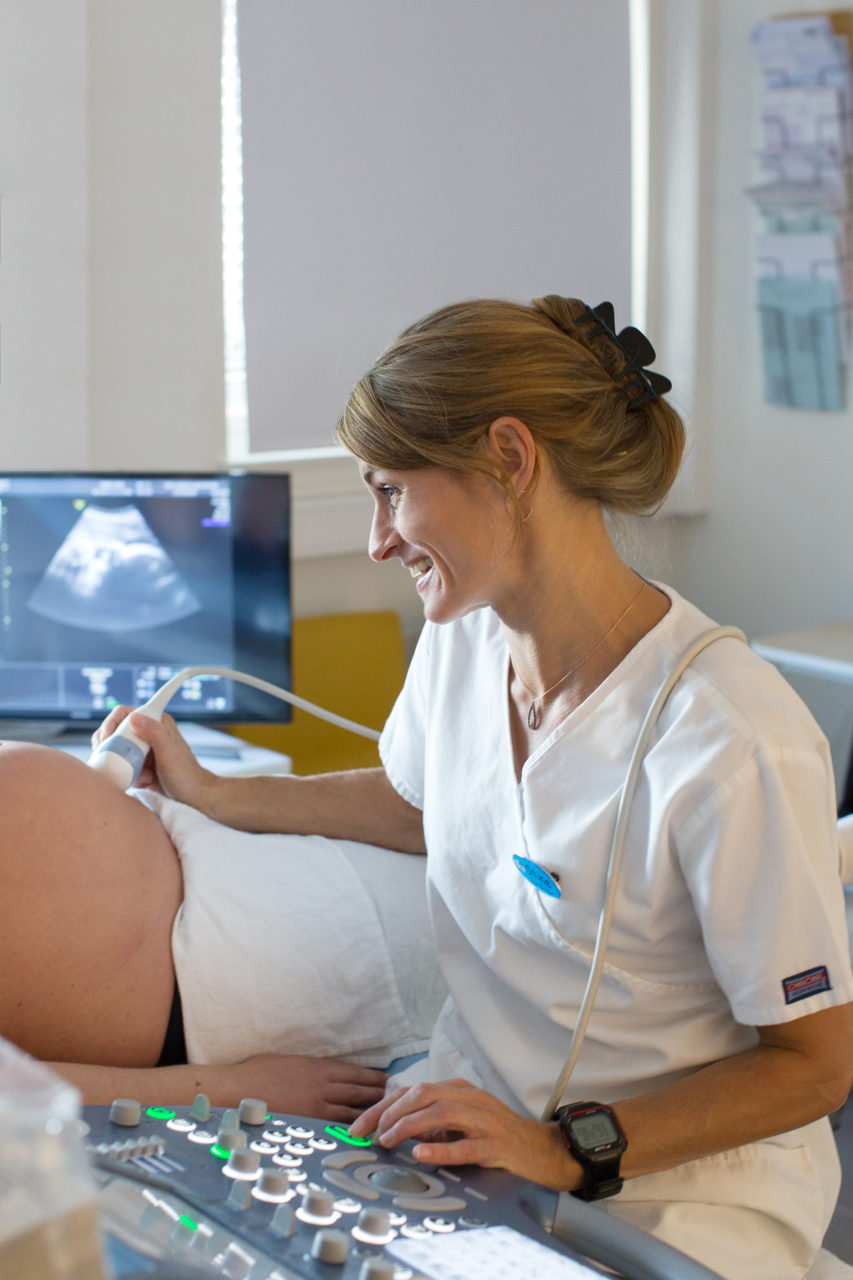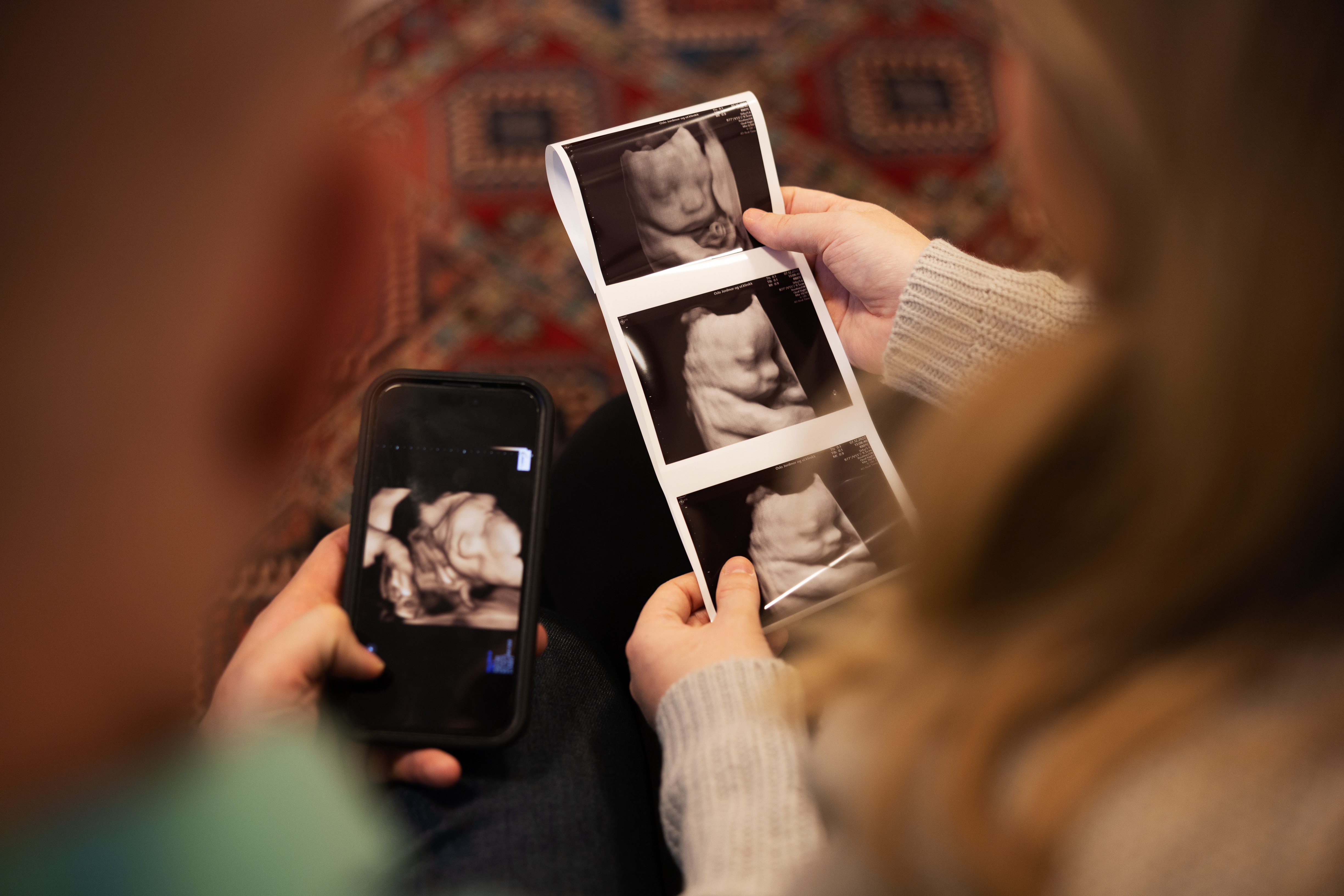
Early ultrasound weeks 12-14
The risk of spontaneous abortion is now greatly reduced. Most miscarriages occur during the first 12 weeks of pregnancy. From now on, this is less common. The foetus's organs are now fully formed, and it is usually serious abnormalities in fetal development that cause the pregnancy to end in miscarriage before week 12.
The foetus is now 52-64 mm long and weighs 20 grams. It looks like a little baby. The face has eyes, nose and a mouth. The eyelids cover the eyes and they do not open until about week 27. 20 small tooth buds are found in the palate.
We can see the skull, two hemispheres of the brain, face and body in profile, arms, legs, neck and body. Since the fetus drinks, we can occasionally see the stomach and bladder. These stand out clearly as two black fluid-filled circles. We see two splayed legs and small soles.
We assess the nuchal translucency and look for nasal bones.
We can also see the position of the placenta in the uterus and the amount of amniotic fluid.
Girl or boy? It can be difficult to see the gender before week 18, but from week 15+0 we can usually see the gender with a high degree of certainty.
The ultrasound is performed abdominally, that is, on the mother's stomach. Sometimes we do it vaginally if the woman's uterus is turned backwards or if she is slightly overweight.
We often get questions from couples who want to book an appointment for an ultrasound examination week 12-14.

They are afraid that the fetus has not developed normally and they want to have the option of terminating the pregnancy within the deadline for self-determined abortion, which is week 12+0. Here, some explanation is necessary.
The right to self-determined abortion in Norway is, as many know, week 12+0. However, if we detect abnormalities after week 12, you are given the opportunity to terminate the pregnancy. If we see anatomical abnormalities in the fetus, we will refer you to further examinations (fetal diagnosis) at the hospital. If serious deviations in the development of the fetus are confirmed and the parents wish to terminate the pregnancy, they are given the opportunity to apply for this at an "abortion board."
During ultrasound examinations, we will examine whether the fetus is developing normally so far in the pregnancy. The ultrasound examination in week 12 will be more comprehensive than in week 7, where we only confirm pregnancy by seeing heartbeats and that the fetus is in the uterus. The ultrasound offered by the public between weeks 17-20, the so-called routine ultrasound, will be a far more detailed examination because the fetus is older and therefore larger. It makes it easier to examine more anatomical details. If serious deviations are discovered in a routine ultrasound, the pregnancy can be terminated after this has been approved by the abortion committee.

Ultrasound weeks 6-7
Before the first 6 completed weeks, the foetus has not developed enough, and we cannot therefore expect to see/hear a heartbeat. Few days play a big role in this context. If you book an appointment before the safe six weeks have passed, the examination might not be able to confirm a heartbeat.
Read more

Ultrasound week 8
This week the brain grows rapidly and the two hemispheres become more distinct. During this week, fingers, toes and elbows begin to form but are difficult to see with a vaginal ultrasound.
Read more

Ultrasound week 11
The overall structure of the brain is now completed. From now on, the brain will further develop specialised structures. However, this does not mean that the brain is fully developed: important substructures in the rough division are not structurally present this early, and it is still a long time before the brain function as it would normally do.
Read more

We send pictures/videos to your phone
All ultrasound examinations include photos and films sent directly to your mobile phone(s). (Unfortunately, the files do not come with audio)
It’s nice if you bring a companion with you. The experience can be somewhat diminished if there are too many people present. This has to do with both space and potential noise issues. Our experience is that children under the age of 5–6 don’t have the proper understanding or appreciation of the ultrasound examination.
You can easily book an appointment that fits your schedule in our calendar.
FAQ
What is ultrasound?
2D (two-dimensional) ultrasound is sound waves that are transmitted from a probe into the body. The sound waves have such a high frequency that they’re inaudible to the human ear.
When the sound waves hit the body tissue, an echo occurs. The echo causes the sound waves to return to the sound head, which captures these sound signals.
After processing on a computer, the incoming audio signals appear as vivid images in black and white on a screen.
Is ultrasound dangerous?
Ultrasounds of pregnant women have been performed for more than 40 years. No adverse effects on women or foetuses have been recorded.
What happens if a missed abortion (MA) is detected at an early ultrasound?
Sometimes it happens that we do not see cardiac activity. This is usually due to a chromosomal abnormality.
We measure the embryo and refer the woman to the hospital she belongs to. Normally she will get an appointment in a few days. There, a gynaecologist will confirm the finding and a surgical or medical abortion will be performed.
The next day we send her a message to check in on her.
In case of suspicion of illness or abnormalities, what happens next?
The midwives who perform ultrasound have completed one year of foetal diagnosis at the National Centre for Emergency Medicine at NTNU. If we see pictures that deviate from the normal we will refer the woman to a maternal-foetal medicine specialist at the National Hospital. She’ll then get an appointment within a few days.
When is ultrasound done internally (vaginal), and on the stomach (abdominal)?
We perform ultrasound vaginally early in the pregnancy, that is, from weeks 6–12. This is because the embryo is so small and the pictures become much clearer on an internal ultrasound.
The woman must lie with her legs in the leg holder with a towel over her. Most people have no problems with this.
Occasionally we also do an internal ultrasound in week 12. This is if the woman has a uterus that is turned slightly backwards or if she’s overweight.
In the case of a 3D ultrasound, the examination is done abdominally.
.jpg?width=200&height=117&name=OJUK%20logo_m%20bindestrek%20(002).jpg)